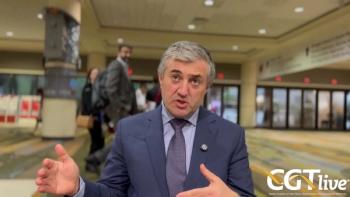
Fabry Disease Gene Therapy Demonstrates Clinically Meaningful Improvements
4D Molecular Therapeutics’ 4D-310 effected clinically meaningful improvements in left ventricular function, exercise capacity, and quality of life.
4D Molecular Therapeutics’ 4D-310, an investigational adeno-associated virus (AAV) vector-based gene therapy intended to treat Fabry disease, has effected clinically meaningful improvements in left ventricular function, exercise capacity, and quality of life in patients treated in the phase 1/2 INGLAXA-1 (NCT04519749) and INGLAXA-2 (NCT05629559) clinical trials.1 The data were presented at the
4D-310, which is administered intravenously, utilizes the C102 AAV vector and is intended to deliver a copy of the GLA gene directly to cardiomyocytes in order to allow for production of the alpha-galactosidase (AGA) enzyme.1,2 In particular, 4D-310 is meant to address Fabry disease-related cardiomyopathy, which is not adequately addressed by currently available Fabry disease therapies. Six patients have been treated with 4D-310 thus far, however only 3 patients with 12 months of follow-up were included in the efficacy analysis. These included Patient 1, a 51-year-old hispanic/latino patient who was on enzyme replacement therapy (ERT) and had a low anti-AGA antibody titer at the time of enrollment; Patient 2, a 32-year-old white patient who was not on ERT and had a high anti-AGA antibody titer at the time of enrollment; and Patient 3, a 26-year-old white patient who was on ERT and had a moderate anti-AGA antibody titer at the time of enrollment. All 3 patients have classic Fabry disease classification.
At the 52-week follow-up time point after treatment with a single dose of 4D-310 (1x1013 vg/kg), Patient 1 showed +2.0 mL/kg/min improvement in peak oxygen uptake from Week 26 and Patient 2 showed a +7.0 mL/kg/min improvement from baseline, both of which were considered clinically meaningful. However, Patient 3 showed a decrease of 2.2 mL/kg/min from baseline at this time point. By comparison, a historical control cohort (n=14) of patients with a median duration of ERT of 48 months showed a mean decrease of –1.8 mL/kg/min.
In terms of global longitudinal strain (GLD), Patient 1 showed a 2.5% decrease from screening at 52 weeks post-treatment, Patient 2 showed a 1.1% decrease, and Patient 3 showed a 3.3% decrease. By comparison, a historical control cohort (n=18) with a median of 4.2 years of ERT showed a mean increase of 1.1%. The minimal detectable difference (MDD) for GLD was defined as 1.5%. On cardiac MRI native T1 measurements, Patient 1 showed a 30.6 ms increase from screening at 52 weeks post-treatment, Patient 2 showed a 9.1 ms increase, and Patient 3 showed a 37.9 ms decrease. By comparison, a historical control cohort (n=18) with a median of 4.2 years of ERT showed a mean decrease of 4.0 ms. The MDD was defined as 29 ms. On the Kansas City Cardiomyopathy Questionnaire Patient 1 maintained a stable 100% clinical summary score at 52 weeks post-treatment, Patient 2 improved by 5.7%, and Patient 3 improved by 10.4%.
In terms of safety, 3 patients experienced cases of transient acute atypical hemolytic uremic syndrome (aHUS). Two of these cases resolved within 2 to 4 weeks. One of the cases, occurring in a 69-year-old male patient, required temporary hemodialysis. It was later discovered that the patient had complement activation prior to receiving treatment with 4D-310. In light of these cases, 4D Molecular Therapeutics paused enrollment in the 2 trials in January 2023 and
“As demonstrated by the positive cardiac outcomes and biopsy biomarker data, these clinical proof-of-concept results with 4D-310 mark another important milestone for 4DMT,” David Kirn, MD, co-founder and chief executive officer, 4D Molecular Therapeutics, said in a statement.2 “This is our third proprietary vector that has been validated in clinical trials across 3 different therapeutic areas, which further validates our Therapeutic Vector Evolution platform. We are developing 4D-310 for the treatment of Fabry disease cardiomyopathy, which is the primary cause of death and not addressed by current therapies. In addition, our focus on patient safety led us to voluntarily pause enrollment on our 2 INGLAXA trials in January 2023 after observing an aHUS dose-limiting toxicity, and FDA subsequently put the program on clinical hold. Following an in-depth investigation in collaboration with world experts in immunology and AAV gene therapy to understand and mitigate aHUS, we are confident that the rituximab and sirolimus immunosuppressive regimen and updated exclusion criteria will mitigate safety risks and potentially further improve patient benefit.”
REFERENCES
1. Schiffmann R, Goker-Alpan O, Vockley J, et al. Cardiac effects of 4D-310 in adults with Fabry disease in a phase 1/2 clinical trial: Functional, quality of life, and imaging endpoints in patients with 12 months of follow up. Presented at WORLDSymposium 2023, held February 22-26, in Orlando, Florida. Abstract #323
2. 4D Molecular Therapeutics Presents Interim Data from 4D-310 INGLAXA Phase 1/2 Clinical Trials & Development Plans for Fabry Disease Cardiomyopathy at WORLDSymposium. News release. 4D Molecular Therapeutics. February 22, 2023. Accessed February 28, 2023. https://ir.4dmoleculartherapeutics.com/news-releases/news-release-details/4d-molecular-therapeutics-presents-interim-data-4d-310-inglaxa
Newsletter
Stay at the forefront of cutting-edge science with CGT—your direct line to expert insights, breakthrough data, and real-time coverage of the latest advancements in cell and gene therapy.
















































